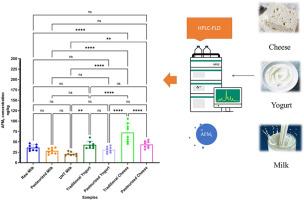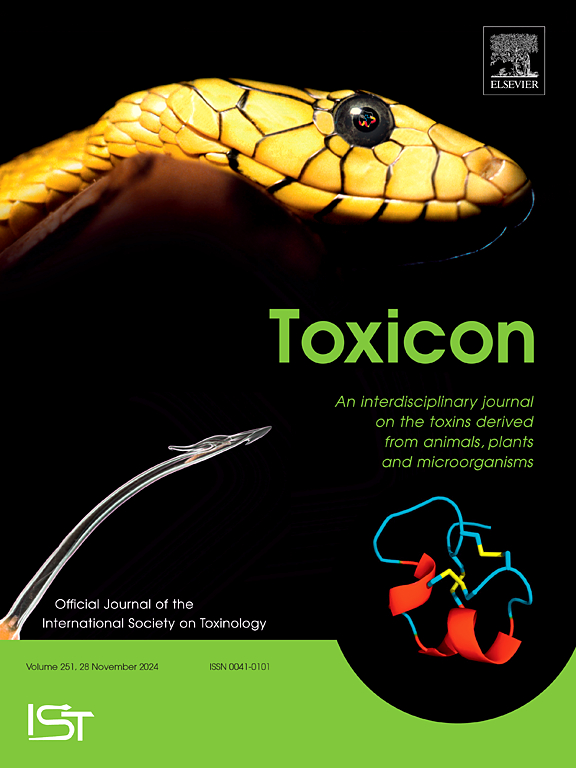伊朗大不里士市牛奶、酸奶和奶酪中的黄曲霉毒素 M1 含量和风险评估。
IF 2.6
4区 医学
Q2 PHARMACOLOGY & PHARMACY
引用次数: 0
摘要
目的和背景:本研究旨在调查从伊朗大不里士采集的牛奶、酸奶和奶酪样本中是否含有黄曲霉毒素 M1(AFM1)。此外,这项研究还对大不里士市牛奶和乳制品的消费进行了风险评估:本研究从 2021 年 12 月至 2022 年 3 月在大不里士随机采集了 56 个样本(生乳、巴氏杀菌乳、超高温乳(UHT)、传统酸奶、巴氏杀菌酸奶、传统奶酪和巴氏杀菌奶酪)。分析采用配备荧光检测器的液相色谱法进行。为进行风险评估,计算了估计膳食摄入量(EDI)和危害指数(HI):所有样本中都检测到了 AFM1。传统奶酪中的 AFM1 浓度最高(P1 低于伊朗国家标准允许的最高限值)。传统酸奶中有 25% 的样品中 AFM1 含量超过了欧盟允许的限值。除儿童牛奶样本的 HI 值大于 1 且表明存在中等风险外,所有样本中成人和儿童消费者的 HI 值均小于 1。总之,牛奶和乳制品中的污染水平和风险评估似乎不会对大不里士的消费者构成公共健康风险。本文章由计算机程序翻译,如有差异,请以英文原文为准。

Aflatoxin M1 level and risk assessment in milk, yogurt, and cheese in Tabriz, Iran
Aim and background
The objective of this study was to investigate the presence of aflatoxin M1 (AFM1) in milk, yogurt, and cheese samples collected from Tabriz, Iran. Additionally, the study conducted a risk assessment related to the consumption of milk and dairy products within Tabriz city.
Study method
For this study, 56 samples (raw milk, pasteurized milk, ultra-high temperature milk (UHT), traditional yogurt, pasteurized yogurt, traditional cheese, and pasteurized cheese) were collected randomly in Tabriz from December 2021 to March 2022. The analysis was carried out using liquid chromatography, which was equipped with a fluorescence detector. The estimated dietary intake (EDI) and the hazard index (HI) were calculated for the risk assessment.
Results and discussion
AFM1 was detected in all samples. The highest concentration of AFM1 was observed in traditional cheese (P < 0.05). The lowest concentration was observed in UHT milk and there were no significant differences between the various milk types and pasteurized yogurt (P > 0.05). Moreover, in all samples, the levels of AFM1 were below the maximum limit permitted by Iranian national standards. AFM1 levels in traditional yogurt exceeded the European Union's permissible limit in 25% of the samples. The HI in all samples was less than one for both adult and child consumers, except for milk samples for children, which were more than one and indicated a medium risk. In conclusion, the levels of contamination in milk and dairy products and risk assessment appear not to pose a public health risk to Tabriz consumers.
求助全文
通过发布文献求助,成功后即可免费获取论文全文。
去求助
来源期刊

Toxicon
医学-毒理学
CiteScore
4.80
自引率
10.70%
发文量
358
审稿时长
68 days
期刊介绍:
Toxicon has an open access mirror Toxicon: X, sharing the same aims and scope, editorial team, submission system and rigorous peer review. An introductory offer Toxicon: X - full waiver of the Open Access fee.
Toxicon''s "aims and scope" are to publish:
-articles containing the results of original research on problems related to toxins derived from animals, plants and microorganisms
-papers on novel findings related to the chemical, pharmacological, toxicological, and immunological properties of natural toxins
-molecular biological studies of toxins and other genes from poisonous and venomous organisms that advance understanding of the role or function of toxins
-clinical observations on poisoning and envenoming where a new therapeutic principle has been proposed or a decidedly superior clinical result has been obtained.
-material on the use of toxins as tools in studying biological processes and material on subjects related to venom and antivenom problems.
-articles on the translational application of toxins, for example as drugs and insecticides
-epidemiological studies on envenoming or poisoning, so long as they highlight a previously unrecognised medical problem or provide insight into the prevention or medical treatment of envenoming or poisoning. Retrospective surveys of hospital records, especially those lacking species identification, will not be considered for publication. Properly designed prospective community-based surveys are strongly encouraged.
-articles describing well-known activities of venoms, such as antibacterial, anticancer, and analgesic activities of arachnid venoms, without any attempt to define the mechanism of action or purify the active component, will not be considered for publication in Toxicon.
-review articles on problems related to toxinology.
To encourage the exchange of ideas, sections of the journal may be devoted to Short Communications, Letters to the Editor and activities of the affiliated societies.
 求助内容:
求助内容: 应助结果提醒方式:
应助结果提醒方式:


